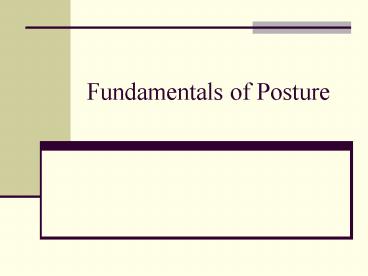Fundamentals of Posture - PowerPoint PPT Presentation
1 / 23
Title:
Fundamentals of Posture
Description:
that state of muscular and skeletal balance which protects ... Palpation. Neurological assessment. References. Kendall, F.P. & McCreary, E.K., et. al. (2005) ... – PowerPoint PPT presentation
Number of Views:4046
Avg rating:3.0/5.0
Title: Fundamentals of Posture
1
Fundamentals of Posture
2
Types of Posture
- Good Posture
- Kyphotic-lordotic Posture
- Flat-back Posture
- Sway-back Posture
3
Correct Posture
that state of muscular and skeletal balance
which protects the supporting structures of the
body against injury or progressive deformity
irrespective of the attitude (erect, lying,
squatting, stooping) in which these structures
are working or resting. Under such conditions the
muscles will function most efficiently and the
optimum positions are afforded for the thoracic
and abdominal organs. (AAOS)
- Maximal biomechanical efficiency
- Minimal stress on ligaments and strain on muscles
4
Normal Spine Curvature
5
Correct Posture (Lateral)
- Line is
- Through external auditory meatus (Ear)
- Midway through shoulder
- Through lumbar bodies
- Slightly anterior to midline of knee
- Slightly anterior to lateral malleolus
6
Poor Posture (AAOS)
faulty relationship of the various parts of the
body which produces increased strain on the
supporting structures and in which there is less
efficient balance of the body over its base of
support. (AAOS)
- Increased strain on body and less efficient
- Cause of various physiological and anatomical
impairments
7
Kyphotic-Lordotic Posture
Head- Forward Cervical Spine- Hyperextended Thorac
ic Vertebrate- increased flexion Lumbar
Vertebrate- lordosis hyperextended Pelvis-
Anterior tilt (forward and down) Knees-
hyperextended Ankle joints- plantar flexed, legs
are behind midline
IDEAL
8
Flat-Back Posture
Head- Forward Cervical Spine- extended Thoracic
Vertebrate- reduced curvature (extension) Lumbar
Vertebrate straight (flexion) Pelvis- posterior
tilt (backward) and down) Hips- extended Knees-
extended Ankle joints- slightly plantar flexed
IDEAL
9
Sway-Back Posture
Head Forward Cervical Spine -Hyper
extended Thoracic Vertebrate- slight
flexion Lumbar Vertebrate slight
extension Pelvis-posterior tilt and anterior to
midline Hips- flexed Knees- Hyper extended
IDEAL
10
Evaluation
- Lateral Evaluation
- Plumb Alignment aligned anterior to lateral
malleolus - Things to Examine
- Position of knees
- Check for hyperextension or flexion
- Pelvic position and spine curvature
- Head, chest and abdominal position
11
Lateral Knee Position
Hyperextension of knees
Flexion of Knees
Good Alignment
12
Anterior Evaluation
- Position of feet
- Check for pronation or supination
- Check arch of the foot
- Position of legs
- Check for bowlegs
- Position of knees
- Check for knock-knees
- Appearance of ribs
- Position of head
13
Anterior Good Alignment
Knee caps face straight ahead
Legs are straight up and down
Arches have normal half-dome shape
Toes are straight
14
Anterior Foot Supination Pronation
Slight knee knocking
Contracted anterior tibalis
Feet are supinated
Weight is on outside of feet
Feet are pronated
15
Evaluation
- Posterior Evaluation
- Plumb Alignment- align midway between heels
- Things to Examine
- Note alignment of Achilles Tendon
- Hip adduction/abduction
- Check for level posterior iliac spine
- Check for lateral pelvic tilt
- Check for spine and shoulder problems
16
Posture of Children
- Child development and flexibility allows for
momentary deviations that would be considered
faulty in adults. - Foot generally flat until 6-7 years of age
- Hyperextension of knees common
- Knock-knee common until 6-7 years of age
17
Scoliosis
- Lateral curve in the spine
- Types of Scoliosis
- Congenital
- Neuromuscular
- Paralytic
- Idiopathic
- 85 of cases
- Unknown Cause
- Adolescent Idiopathic Scoliosis (AIS)
18
Scoliosis Perform Posture Analysis
- Check if shoulders are level
- Check distance between arms and side of body
- Check if hips are level
- Check if head is centered over the pelvis.
19
Scoliosis
- Shoulders not level, prominent or uneven scapulas
- Uneven gap between arm and body
- Elevated or uneven hip
- Head not centered over pelvis
- Bending test reveals uneven portions of back
20
Example
21
Perform Forward Bending Test
- Determine if curve is structural or functional
- Structural- prominence seen in forward bending
- Functional-no prominence seen in forward bending
22
Scoliosis Examination Summary
- Physical assessment
- Cardiopulmonary
- Adams Forward Bending Test
- Leg length
- Plumb line
- Range of motion
- Palpation
- Neurological assessment
23
References
- Kendall, F.P. McCreary, E.K., et. al. (2005).
Muscles Testing and Function with Posture and
Pain (5th ed.). Baltimore Williams Wilkins. - American Academy of Orthopaedic Surgeons.
Available online http//www.aaos.org/ - http//www.scoliosis-australia.org/scoliosis/about
_scoliosis.html (forward bending image) - http//www.aafp.org/afp/20020501/1817.html
(scoliosis) - http//orthoinfo.aaos.org/brochure/thr_report.cfm?
Thread_ID14 (slide 23) - www.nlm.nih.gov































